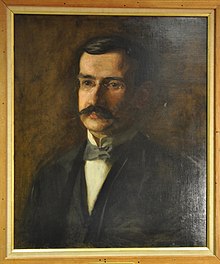Charles Lester Leonard | |
|---|---|
 | |
| Born | December 29, 1861 |
| Died | September 22, 1913 (aged 51) |
| Medical career | |
| Profession | Medicine |
| Field | Radiology |
| Institutions | Hospital of the University of Pennsylvania |
| Signature | |
Charles Lester Leonard (1861–1913) was an American physician and X-ray pioneer. Leonard was the first radiologist at the Hospital of the University of Pennsylvania, founded the Philadelphia Roentgen Ray Society, and served as president of the American Roentgen Ray Society in 1904–1905. He was known as one of the foremost experts in urological X-ray diagnosis, and he was the first American physician to demonstrate kidney stone disease with X-rays.
A native of Massachusetts, Leonard completed bachelor's degrees at the University of Pennsylvania and Harvard University, then returned to Penn for medical school. As a student, he was interested in photography, and after going to Europe to work in science laboratories, he developed an interest in photomicrography. Leonard captured microscopic images that furthered the understanding of the life cycles of microorganisms.
Leonard was associated with University Hospital from the mid-1890s to 1902. He was first named an assistant instructor in clinical surgery under J. William White, and then he ran the hospital's X-ray service, which seemed to combine his interests in photography and surgical problems. While he was at Penn, Leonard opened a private office for taking X-rays. After he left the medical school, he devoted his time to this private practice as well as to writing about radiology and representing the specialty nationally and internationally at medical conferences.
Like many of the pioneers in radiography, Leonard suffered from adverse effects of radiation exposure before the causes of these problems were fully understood. During his first several years of X-ray work, he believed that X-ray burns resulted from ungrounded electrical current, so he did not take precautions to shield his body from radiation. Before he died of radiation-induced cancer, Leonard had multiple operations, including the amputation of his entire right arm.